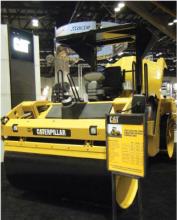
A new generation of asphalt compaction technology is coming to market, reports Mike Woof
The market for rubber tyred compactors has grown in recent years, prompting manufacturers to develop a new generation of machines. However the biggest portion of machine sales into the asphalt compaction sector will be for twin drum units, with firms introducing a raft of new and improved models during this year.
Amman is adding to its line-up of heavy articulated tandem rollers with its AV120X, which is targeted at the12tonne class. This comes in addition to the existing 7tonne AV70X, 8tonne AV80X, 10.5tonne AV110X and 13tonne AV130X and the new model shares the compact design of its stablemates. The split drum design and adjustable crab steering boost versatility and manoeuvrability. The engine is mounted at the rear of the chassis and the machine features a hydrostatic drive with twin pumps. The machine offers working widths of 1.880-2.204m and amplitudes of 0.7/ 0.35mm.
Also new from Ammann are the AV85/95-2 medium-sized tandem rollers. Power comes from
An innovative development comes from German firm
Called active amplitude management, the new target value package allows the user to achieve more efficient compaction processes according to BOMAG. Trials on an array of construction sites have helped refine the algorithm for automatic stiffness-related amplitude control. The improved system is said to help optimise compaction performance and surface quality, while reducing the number of passes required for the design specification. This also allows high amplitudes to be used, while avoiding the risks of drum bounce, surface irregularities, or aggregate crushing.
The operator can also use a compaction manager tool that helps reduce the risk of work not meeting specification. In automatic mode the system works individually on the selected asphalt layer and limits the amplitude on thin layers. The amplitude is reduced when compaction resistance is too high, such as when the compacted area is coming close to its required specification, or when the material is too cold. Efficient management helps the driver optimise compaction, particularly when the asphalt is hot during initial working.
Providing an efficient control of amplitude improves the accuracy of the stiffness module EVIB and makes this easier to repeat, according to BOMAG. The firm says its trials have shown that unwanted subsurface effects can be reduced by quick adjustment of the compaction and measuring depth on the layer being worked. This prevents any misinterpretation of the stiffness module arising from any weakness in the subsurface and delivers a better material density.
BOMAG also has a new pivot-steered tandem roller in the 10tonne class. A new ECOMODE system makes the BW174AP economical to run, with tests showing fuel savings of over 20% in comparison with the earlier machine. An active engine management package delivers power as required and cuts engine output, using an intelligent sensor system. This monitors power requirements and automatically adjusts the speed of the
The position of the roller is set according to a GNSS receiver with an accuracy of about 200mm. During rolling sensors measure the surface temperature of the mix while the system records machine position. This data is then relayed to the operator in the cabin by the on-screen compaction map and this changes colour in areas where the correct number of passes have been made. As the map changes colour the operator can move through the different sections and the system is said to allow far more accurate compaction results.
When the quality control team tests the asphalt with nuclear gauges or core samples, results can be checked against the system's documented records. If the asphalt is poorly compacted, faults can be traced to identify where mistakes were made.
Aimed at high performance compaction work,
The firm has re-designed the articulation joint to improve weight distribution and stability, as well as to boost compaction performance. Features include good visibility of the roller drums and the water sprinkling system due to the compact chassis and large cab. The control panel moves with the seat, which the operator can turn to give a better view of the working area. A bigger water tank allows operation for a full shift without need for refilling, while the machines deliver higher overall productivity than before.
The HD+ range also includes a high-frequency version for the US market, where paving production rates are higher and compaction machines need to be able to keep pace. And the HD+ 90 is offered with drum vibration as well the firm's novel drum oscillation system as an option.
Hamm also upgraded its compact asphalt roller range by fitting new engines from Kubota that offer increased performance and lower fuel consumption. The range includes 11 models that weigh from 1.5-4.2tonnes and the new Kubota diesels are said to boost output by around 15% for the HD13 and HD14 models. For operator comfort, the operator platforms have more insulation to reduce vibration, while additional handles provide easier access. In addition the machines now come with a new throttle control that allows engine speed and vibration drive speed to be adjusted.
At the smaller end of the compaction market, Stone Construction Equipment is extending its line with a new double-drum, walk-behind roller. The new WBR650 walk-behind roller is designed to be a versatile machine, with a 648mm wide drum and drives through a hydrostatic transmission. The firm says that the machine can be used on a wide variety of applications such as bridge abutments, larger sidewalks, parking lots and road shoulders. A compact design allows the roller to be used in restricted space applications such as in trenches as well as in general asphalt patching and repair work.
Power for the WBR650 comes from a 7.5kW
The machine features centrally located eccentrics that are said to distribute compaction forces evenly over the drums, while a low centre of gravity maximises stability and manoeuvrability. Ergonomically designed controls are fitted for speed, direction and vibration and these are said to be easy to operate.










